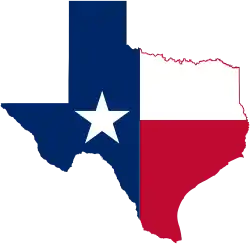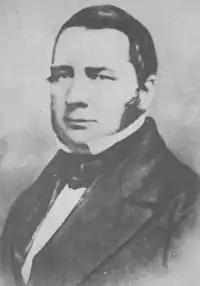Supreme Court of the Republic of Texas
The Supreme Court of the Republic of Texas was the court of last resort for legal matters in the Republic of Texas from the Republic's independence from Mexico in 1836 until its annexation by the United States of America in 1846. The current Supreme Court of Texas was established that year.
| Supreme Court of the Republic of Texas | |
|---|---|
.svg.png.webp) Seal of the Republic of Texas | |
| Established | 1836 |
| Location | Austin, Texas |
| Composition method | Congressional election |
| Authorized by | Constitution of the Republic of Texas |
| Number of positions | Chief Justice, 7 District Judges (ex officio members) |
Part of a series on the |
||||||||||||||||||
|---|---|---|---|---|---|---|---|---|---|---|---|---|---|---|---|---|---|---|
| History of Texas | ||||||||||||||||||
 | ||||||||||||||||||
| Timeline | ||||||||||||||||||
|
||||||||||||||||||
|
| ||||||||||||||||||
Organization of the Court
The Court was established by the Constitution of 1836, which created the Supreme Court and such inferior courts as the Texas Congress might from time to time establish.[1] The constitution also mandated that the Republic be divided into judicial districts, and that the district judges would serve as the associate judges on the Supreme Court, along with a Chief Justice.[2] The judges were elected by Congress for a term of four years.[3] The district judges rode the circuit in their district during the spring and fall, leaving only the summer and winter for the judges to sit as the Supreme Court.[4]
Jurisdiction
The Court had unlimited appellate jurisdiction.[5] In the first statute establishing the district courts, Congress set $300 as the minimum amount in controversy for the appeal of a decision from the district court to the Supreme Court.[6] In 1841 the Court declared that limit unconstitutional in Morton v. Gordon and Alley,[7] stating that all final judgments of the district courts were able to be appealed to the Supreme Court.[8] The same district court enabling act did not provide for appeal to the Supreme Court of criminal matters, which the Court resolved in Republic v. Smith,[9] stating that the constitution gave jurisdiction to the Court over all criminal appeals.[10]
Operation of the Court
On December 15, 1836, the Texas Congress passed the implementing statute establishing the courts of Texas, and elected the chief justice and four district judges the next day.[11] The four district judges covered 22 counties and were ex officio members of the Supreme Court.[12] The court was to meet for one session a year, beginning on the first Monday in December, and required a majority of the judges to be present.[13] The opinions of the court are collected in a private reporter, Dallam's Decisions, in only one volume.[14]
Justices of the Court

Chief Justices
The Court had a Chief Justice and originally four district judges who served as associate judges.[15] This was expanded to five in 1838[16] and seven in 1840.[17] The first Chief Justice was James Collinsworth, who was an ally of Sam Houston, the president-elect of the new republic.[fn 1][19] On Collinsworth's death, Houston appointed John Birdsall to the post.[20] When Mirabeau B. Lamar became President, Congress refused to confirm Birdsall and elected Thomas Jefferson Rusk instead.[fn 2][22]
In 1840, Rusk resigned and was replaced by John Hemphill, who served until the annexation of Texas.[fn 3].[24] The election in Congress was contested, with John Scott, former Solicitor General of North Carolina;[25] James Webb, former U.S. District judge and Attorney General of Texas; and Hemphill all in the running for Chief Justice.[26] Hemphill has been compared to John Marshall in laying down the legal foundation of Texas law, especially in the area of land titles, marital property, and homestead exemptions.[27]
District judges
The original four district court judges elected by Congress were Shelby Corzine, Benjamin Cromwell Franklin,[fn 4] Robert McAlpin Williamson, and James W. Robinson.[29] Due to delays in the Supreme Court sitting in session, these four judges (along with the first two chief justices) never sat with the Supreme Court.[30]
Succession of seats
|
|
| ||||||||||||||||||||||||||||||||||||||||||||||||||
|
|
| ||||||||||||||||||||||||||||||||||||||||||||||
|
|
| ||||||||||||||||||||||||||
Sessions
1837 and 1839

No session was held in 1837, probably because a majority of the judges were not present.[39] Two weeks after the Court was supposed to have met, Congress passed a statute which would impose a $1,000 fine on a judge who did not appear for a session.[40] A short time later, Congress eliminated the scheduled 1838 session when it moved the annual date to the second Monday in January.[41] In the meantime, Collinsworth died and Houston replaced him with Birdsall until Congress could meet and elect a new Chief Justice. Rusk was elected, but did not receive word of his election until after the 1839 session had been scheduled to occur and been canceled for lack of a Chief Justice.[42]
1840
The first session in which the Texas Supreme Court met was the January 1840 session, in Austin.[43] The Court consisted of Chief Justice Rusk, and District Judges Shelby, W.J. Jones, Mills, and Hemphill. The clerk was W. Fairfax Gray.[44] The court disposed of 49 cases on its docket, but issued only 18 opinions.[45] Thirteen cases were decided without opinion; the rest were continued to the following term.[46] The court issued what appear to be the first writ of mandamus and first writ of habeas corpus in Texas.[fn 5]
1841

The January 1841 session was attended by Chief Justice Hemphill and District Judges Baylor, Hutchinson, Terrell, Scurry, and Hansford. Gray was the clerk. The District Judges from the First and Second Districts were not in attendance.[49]
1842
The January 1842 session was attended by Chief Justice Hemphill and District Judges Morris, Baylor, Hutchinson, Ochiltree, Jack, and Mills. Thomas Green was the clerk. The District Judge from the Second District did not attend.[50]
1843
The June 1843 session was attended by Chief Justice Hemphill and District Judges Morris, Baylor, Ochiltree, and Jack. Green was the clerk. The District Judges from the Second, Fourth, and Seventh Districts did not attend.[51]
1844
The June 1844 session was attended by Chief Justice Hemphill and District Judges Morris, W.J. Jones, Baylor, W.E. Jones, Ochiltree, and Jack. Green was the clerk. The District Judge from the Seventh District did not attend.[52]
1845
The December 1845 session was the last session of the Court. It was attended by Chief Justice Hemphill and District Judges J. B. Jones, W. J. Jones, Baylor, W. E. Jones, Wheeler, and Norton. Green was the clerk. The District Judge from the seventh district did not attend.[53]
References
Footnotes
- Collinsworth was 30 years old, had been the U.S. Attorney for the Western District of Tennessee, and signed the Texas Declaration of Independence and help draft the Constitution. He drowned in 1838 while running for President, to replace Houston.[18]
- Although required to convene on the first Monday of December (later changed to January), the Court had never had a quorum until Rusk convened it in January 1840.[21]
- Hemphill served as Chief Justice until 1958, when he was appointed U.S. Senator, replacing Sam Houston.[23]
- Judge Franklin has the distinction of being the first judge appointed by the Republic, abet outside of the required process. The Texas Navy had captured a United States ship, the brig Pocket, which was carrying contraband to a Mexican port. President David G. Burnet appointed Franklin as a district judge to hear the case.[28]
- The mandamus was issued in Dangerfield v. Secretary of State[47] and the habeas was issued in Republic v. Bynum[48]
Notes
- Tex. Const. art. IV § 1 (1836); 1 The Laws of Texas, 1822-1897 1073 (Hans Peter Mareus Neilsen Gammel ed. 1898); James W. Paulsen, A Short History of the Supreme Court of the Republic of Texas 65 Tex. L. Rev. 237, 240-41 (1986).
- Tex. Const. art. IV §§ 2, 7 (1836); Gammel, 1 Laws at 1073-74; Paulsen, Short History at 240-41.
- Jewette Harbert Davenport, The History of the Supreme Court of the State of Texas: With Biographies of the Chief and Associate Justices 7 (1917).
- Paulsen, Short History at 241.
- Tex. Const. art. IV § 8 (1836); Gammel, 1 Laws at 1074; Paulsen, Short History at 241.
- Act of Dec. 22, 1836, § 15; Gammel, 1 Laws at 1263; 1 Year Book for Texas 96-97 (Cadwell Walton Raines ed. 1902); Paulsen, Short History at 242.
- Morton v. Gordon and Alley, Dallam 396 (1841); Paulsen, Short History at 242 n.19.
- Raines, at 97.
- Republic v. Smith, Dallam 407 (1841).
- Raines, at 97.
- Paulsen, Short History at 248.
- James L. Haley, The Texas Supreme Court: A Narrative History, 1836–1986 18 (2013).
- Haley, at 18.
- Davenport, at 14.
- Act of Dec. 15, 1836, § 1; Act of Dec. 22, 1836, § 1; Gammel, 1 Laws at 1139, 1258; Paulsen, Short History at 241.
- Act of May 24, 1838, §§ 1, 6; Gammel, 1 Laws at 1500-02; Paulsen, Short History at 241.
- Act of Jan. 29, 1836, § 1; Gammel, 2 Laws at 350-51; Paulsen, Short History at 241.
- James Daniel Lynch, The Bench and Bar of Texas 64 (1885); Haley, at 19; Raines, at 93.
- Haley, at 19; Raines, at 93; Stanley Siegel, A Political History of the Texas Republic, 1836-1845 56 (2010).
- Raines, at 93.
- Haley, at 20.
- Lynch, at 67; Haley, at 19-20; Raines, at 94.
- 1 Great American Judges: An Encyclopedia 374 (John R. Vile ed. 2003).
- Lynch, at 70; Haley, at 20; Raines, at 94.
- Profile of John Scott at University of Texas School of Law Library; Retrieved 31 December 2015.
- Paulsen, Short History at 254.
- The Yale Biographical Dictionary of American Law 260-61 (Roger K. Newman ed. 2009); Vile, at 370.
- C.T. Neu, The Case of the Brig Pocket, 12 Q. of Tex. St. Hist. Ass'n 276 (1909).
- Raines, at 95; Seigel, at 56.
- Paulsen, Short History at 248.
- James W. Paulsen, The Judges of the Supreme Court of the Republic of Texas, 65 Tex. L. Rev. 305 (1986).
- Paulsen, Judges at 305.
- Paulsen, Judges at 305.
- Paulsen, Judges at 305.
- Paulsen, Judges at 305.
- Paulsen, Judges at 305.
- Paulsen, Judges at 305.
- Paulsen, Judges at 305.
- Paulsen, Short History at 249.
- Act of Dec. 14, 1837; Gammel, 1 Laws 1400; Paulsen, Short History at 249.
- Act of May 24, 1838 § 7; Gammel, 1 Laws 1500, 1502; Paulsen, Short History at 250.
- Paulsen, Short History at 250-52.
- Paulsen, Short History at 253.
- Raines, at 97-98.
- Paulsen, Short History at 253.
- Paulsen, Short History at 253 n.100.
- Dangerfield v. Secretary of State, Dallam 358 (1840).
- Republic v. Bynum, Dallam 376 (1840).
- Raines, at 98.
- Raines, at 98.
- Raines, at 98.
- Raines, at 98.
- Raines, at 99.